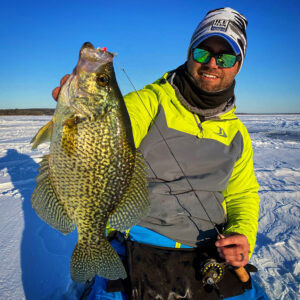By Bob Jensen

(photo by Bob Jensen) Sometimes big crappies prefer small baits.
Ice fishing opportunities have been limited in my part of the world so far this ice fishing season. Warmer than usual temperatures have created inconsistent ice conditions. It’s been challenging to find a place to safely go ice fishing.
In an effort to satisfy my desire to go fishing, I called my ice fishing go-to for fishing information. John Crane is a world-class lure designer and a heck’uva fisherman. J.C. told me what I thought he would: I’m going to need to drive several hours north of my home in Iowa, and even then the ice conditions will be questionable.
J.C. said that he had been out, but only on smaller lakes. Our next topic of conversation centered on lures and some on-going changes in lure construction. As usual, J.C. had some interesting insights.
Tungsten and zinc alloy lures have become popular in the past few years. Those materials replace lead and are friendlier to our environment. Lead negatively impacts the world in several ways. That’s why gas with no lead and paint with no lead is offered and widely accepted.
People in some places have learned the hard way that lead in the drinking water is a bad deal. In many ways, tungsten and zinc alloy are better for wildlife, people, and fishing.
When it comes to ice fishing, tungsten offers several advantages over lead. Tungsten is denser than lead.A 1/16-ounce tungsten jig is physically smaller than a 1/16-ounce jig. Fish in the winter, especially panfish, often like smaller baits.
A tungsten jig will get to the fish faster than a jig made of lead, and because it’s smaller, the fish will more readily eat it. Drop Jigs and Swirl Drop Jigs are good examples of tungsten jigs.
Because tungsten is denser than lead, it’s also more sensitive, and that’s an advantage in open water or under the ice. An angler can feel a fish take a bait made from tungsten better than a bait made from lead. Maybe not a lot better, but better, and that can be a big advantage when the bite is soft.
Now about the benefits of zinc alloy and a reason why fish might be more likely to eat a bait made of zinc alloy. Zinc alloy enables lure manufacturers to offer greater detail to a lure. On a zinc alloy lure, eyes look more like fish eyes, and gills and scales look more like minnow gills and scales. The use of live bait isn’t as necessary with these baits.
No live bait to mess with makes moving from hole to hole easier. Moving from hole to hole makes it more likely that we find fish, and finding fish means our odds for success go up. J.C. told me that he has been spending a lot of time with a Pinhead Pro Spoon or Tikka Flash on the end of his line. These are both made from zinc alloy. He’s catching a lot of perch, crappies and walleyes, and is using a lot less live bait.
Clam Tackle is a leader when it comes to lures made from tungsten or zinc alloy. Eighty five percent of their ice lures are made from these materials. Lures made from tungsten originally cost more than lures made from lead, but those prices have evened out. If you haven’t made tungsten or zinc alloy lures part of your fishing arsenal, you should consider doing so.


















